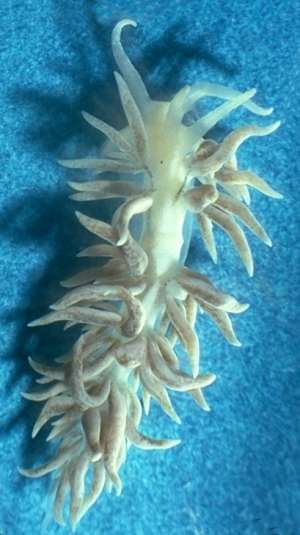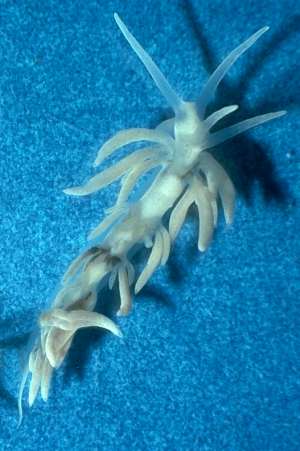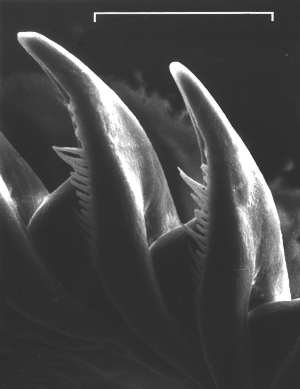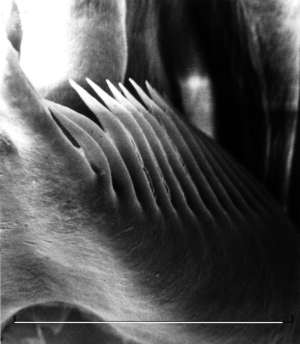

Phyllodesmium pecten
Rudman, 1981
Order: NUDIBRANCHIA
Suborder: AEOLIDINA
Family: Glaucidae
DISTRIBUTION
Known only from Dar es Salaam, Tanzania
PHOTO
Fungu Yasin Reef, off Kunduchi Beach, Dar es Salaam, Tanzania, 10 m on Xenia colony, October 1976. Paratypes AM C120782. Upper: 22 mm long alive. Lower: 12 mm long alive. Photos: Bill Rudman.
The body is translucent, sometimes with a yellowish tinge, and there is a distinct pattern of white pigmentation. The upper halves of the oral tentacles and rhinophores are white, and on the head is an inverted triangular white patch, the apex of the triangle joining a white band running across the head just in front of the rhinophores. Just behind the rhinophores is a triangular white patch, and down the centre line between each ceratal cluster is a diamond shaped white patch. Ducts from the stomach to the digestive gland in the cerata show through the body wall in plales as irregular brown lines. The cerata are with white with some translucent patches, and the pale creamy brown digestive gland shows through as a faint cream-brown tinge.
In the larger specimens, the cerata are arranged in six clusters on each side. The most anterior cluster, in front of the pericardium, are arranged in a single-rowed arch. The first cluster behind the pericardium is also a single-rowed arch, while the remaining cerata are arranged in four single rows on each side. The foot is approximately twice the width of the body, the leading edge of which is extended into foot corners. The oral tentacles taper to a blunt point and are rather thick basally. The rhinophores are smooth, approximately two-thirds the length of the oral tentacles.
Known only from four specimens collected in Dar es Salaam, ranging in size from 4 - 22 mm lonng alive. They crawled out of a colony of Xenia. When disturbed they would cast cerata which would wiggle for some time [see Fact Sheet on autotomy ]. The radular teeth are illustrated in a separate message [#12625 ]. The name 'pecten' refers to the very long denticles on the radular teeth which give it a comb-like appearance [pecten in Latin = comb].
-
Rudman, W.B. (1981) The anatomy and biology of alcyonarian-feeding aeolid opisthobranch molluscs and their development of symbiosis with zooxanthellae. Zoological Journal of the Linnean Society, 72: 219-262.
Rudman, W.B., 2004 (December 24) Phyllodesmium pecten Rudman, 1981. [In] Sea Slug Forum. Australian Museum, Sydney. Available from http://www.seaslugforum.net/find/phylpect
Related messages
Radula of Phyllodesmium pecten
December 24, 2004
From: Bill Rudman


To accompany the Fact Sheet on Phyllodesmium pecten, which I have just posted, here are some scanning electron micrographs of the radula. The radula of species of Phyllodesmium consists of a single median tooth in each row. The individual teeth usually have many small denticles down each side of the blade, but in this species the denticles are very long, giving the teeth a comb-like appearance. I gave this species the name 'pecten' [pecten in Latin = comb] because of the shape of the radular teeth.
PHOTOS: SEM of radular teeth. Upper: lateral view of 2 teeth. Note many broken denticles - not sure if this is through normal wear & tear or a result of the SEM preparation. Lower: Close-up showing denticles. Scale bar = 50 µm in each case. Photos: D. Hughes.
-
Rudman, W.B. (1981) The anatomy and biology of alcyonarian-feeding aeolid opisthobranch molluscs and their development of symbiosis with zooxanthellae. Zoological Journal of the Linnean Society, 72: 219-262.
Bill Rudman
Rudman, W.B., 2004 (Dec 24) Radula of Phyllodesmium pecten. [Message in] Sea Slug Forum. Australian Museum, Sydney. Available from http://www.seaslugforum.net/find/12625